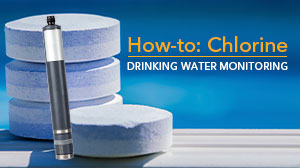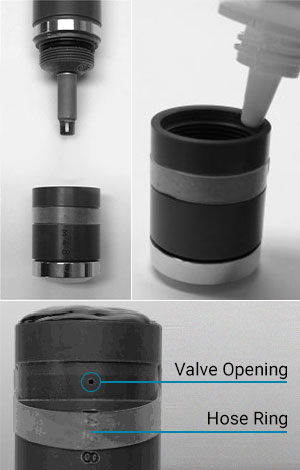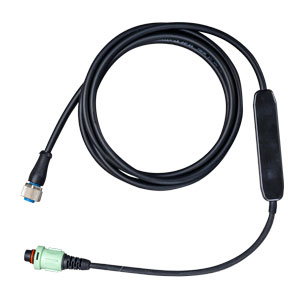2/3/2025
| Dr. Lisa Wild
Find out here how to commission the WTW chlorine sensor correctly, how to ensure measurement accuracy with the right maintenance intervals and how to minimize maintenance work at the same time.
The WTW Chlorine Sensor FCML: Continuous Monitoring for Safe Drinking Water
 Chlorine is a crucial parameter for monitoring drinking water quality as it helps to eliminate potentially harmful contaminants. As a corrective parameter, chlorine plays a central role in the drinking and food quality of our tap water by killing germs and pathogens. At the same time, however, the chlorine concentration must be kept as low as possible and below the national limit values. To ensure this, precise and continuous measurement of the chlorine content in drinking water is required.
Chlorine is a crucial parameter for monitoring drinking water quality as it helps to eliminate potentially harmful contaminants. As a corrective parameter, chlorine plays a central role in the drinking and food quality of our tap water by killing germs and pathogens. At the same time, however, the chlorine concentration must be kept as low as possible and below the national limit values. To ensure this, precise and continuous measurement of the chlorine content in drinking water is required.
The WTW Drinking Water Panel offers a modular solution for continuous chlorine monitoring with the amperometric sensor FCML. This sensor enables real-time monitoring with high sensitivity,, i.e. even low chlorine concentrations are reliably detected. Other advantages of the sensor include chemical-free operation and easy maintenance and calibration.

Filling the membrane cap with electrolyte
Commissioning the FCML Sensor
Filling the membrane cap with electrolyte
Before the sensor is installed, the membrane cap must be filled with the electrolyte supplied:
- The membrane cap must first be unscrewed from the electrode shaft.
- Place the membrane cap on a clean (non-absorbent) surface.
- Cut the tip off the dropper bottle until the opening in the tip is visible and fill the membrane cap to the brim with electrolyte solution without bubbles.
- Lift off the hose ring of the membrane cap, which closes the valve opening, from the side so that the valve opening is exposed (see picture).
- Hold the sensor shaft vertically and place it on the filled membrane cap. Electrolyte solution will run out over the upper edge of the membrane cap
- Screw the electrode shaft into the membrane cap.
- Place the hose ring over the valve opening using a blunt object, e.g. a pen, and insert evenly into the groove.
- Rinse off the electrolyte solution adhering to the outside with water.
Initialization
To ensure that the sensor functions properly, it must be initialized correctly. This is done in 3 steps:

ADA Cl/IDS adapter cable
- Connection to IQ Sensor Net
To connect the chlorine sensor to the IQ Sensor Net, the blue round end of the ADA Cl/IDS adapter cable must first be plugged into the chlorine sensor and then screwed shut and then the mint-colored end must be connected to the MIQ/IDS module with the IDS plug.
- Setting the correct sensor type in IQ Sensor Net
After starting the controller, the sensor type must be selected in the IQ Sensor Net menu. Depending on which sensor you have ordered, please select one of the two sensors:
- Free chlorine up to 2 mg/l → FCML 412 M12-2
- Free chlorine up to 20 mg/l → FCML 412 M12-20
- Polarization in chlorine solution with min. 5 mg/l
For this purpose, the connected sensor, which is supplied with operating voltage, is immersed for one hour in a well-stirred chlorine solution containing at least 5 mg/l chlorine.
Installing the sensor for accurate continuous measurement
After initialization, the sensor can now be installed in the flow cell D19 of the Drinking Water Panel. The sensor should be positioned correctly in the water flow (marking on the label) and a minimum flow rate of 15 l/h should be ensured in order to achieve accurate measurements. The flow rate can be set directly on the Drinking Water Panel on the valve or flow regulator and checked on the flow rate display.
After installation in the flow cell, the sensor should soak in the water for approx. half an hour before carrying out an initial calibration. A recalibration should be carried out after approx. 24 hours.
Maintenance and Calibration of the Amperometric Chlorine Sensor
Continuous measurement with the FCML sensor is simple and convenient but requires regular reference measurements to ensure accuracy. Regular means that a reference measurement is taken every week. A reference solution is used to validate and, if necessary, adjust the measured values of the sensor. A calibrated photometer is recommended for the reference measurement.
If the reference measurement is not within the accuracy limit of <1 % one or all of the following maintenance steps must be carried out:
- Calibration: approximately every 1 to 2 months
- Electrolyte replenishment: about every 6 months
- Replacing the cap: approximately every 12 months
Please check your maintenance plan to see which of these 3 steps is most likely.
It should also be noted that only cleaned sensors without electrolyte are suitable for long-term storage or transportation. Sensors filled with electrolyte should be permanently connected to the power supply and stored in water. Otherwise, specific, sometimes irreparable changes may occur to the membrane cap, the sensor finger and the electrolyte.
The sensor must be re-polarized and recalibrated each time it is refilled with electrolyte, or the cap is replaced.
Conclusion
Amperometric chlorine measurement in drinking water is an essential process for ensuring drinking water quality and hygiene. Der WTW chlorine sensor FCML eenables efficient, precise and reliable monitoring of the chlorine concentration in water, while simple maintenance procedures minimize the effort and ensure the safety of the drinking water supply. The installation of the FCML sensor requires careful steps such as filling the membrane cap with electrolyte and correct initialization via the IQ Sensor Net. After installation in the flow cell, it is recommended that the sensor is run in and calibrated regularly to ensure measurement accuracy. Maintenance of the sensor includes regular calibration every 1-2 months as well as checking and, if necessary, replacing the membrane cap every 12 months. This ensures reliable long-term operation of the sensor.

You may also be interested in these blog articles:
Products for the chlorine measurement in drinking water and other areas of application (a selection):